In the indoor training world there are roller people, and there are trainer people. It’s sorta like politics or religion. Fighting with one camp over the benefits is mostly futile. The only people who benefit from such discussions are the social media platforms themselves and ad sales.
But every once in a while there’s a tweak to technology on one side of the DMZ or the other, and a few people defect. For example, the addition of rocker plates and similar rocking technology has swayed some roller people over to the trainer side. And inversely, with more and more rollers incorporating ‘crash reduction’ concepts into their designs – they’ve stolen a few trainer people away.
But at their core – they’re roughly two different concepts. Like it or not, rollers take more concentration to ride and you can fall off them (can = will, if not paying attention). But they also more correctly simulate the side to side movement of the bike and body compared to out on the road.
While I’ve toyed with various rollers in the past, I’m just not a roller person. And no amount of telling me why rollers are somehow better is going to change that. I’ve got plenty of things to do in my life, and falling off my bike in my living room and crashing into the TV is not one of them.
However, InsideRide semi-recently introduced the floating fork stand. This concept basically adds a floating fork mount to the front of the roller platform, making it nearly impossible to accidentally fall off of the rollers. Yet at the same time preserving much of the motion feel (including front/back/tilt/rotate). Plus all the usual smart trainer type stuff like resistance control for apps such as Zwift & TrainerRoad.
In other words, they made rollers for people who hate rollers.
Sign me up! Maybe.
Oh – and if you want a quick overview of this whole swaying thing, check out the below video:

See, it’s pretty cool, huh?
Understanding the Puzzle Pieces
My focus of the majority of this review is frankly on the front fork stand and smart control pieces. That’s why I’m interested in this device over others. I don’t review non-smart rollers, because that’s not my jam. And heck, I rarely review rollers – as again, also not my jam.
Still, you’ve basically got three ‘pieces’ here that make up the package that is this review. The base of every InsideRide E-Motion rollers kit is the actual rollers themselves. By and large this hasn’t changed much over the years, but that’s not a bad thing. That means that even if you’ve got rollers sitting around from half a decade ago – they’re still totally compatible here:
The base E-Motion rollers can be used as-is, without any extra smart control or fork bits. And in fact, I have used them in the past that way. This main portion costs $900, but does incorporate the ‘e-motion’ concept, which means the whole platform slides front and back as you’ll see in the video.
Next, there’s the smart control unit (aka ‘SmartPower’ resistance control unit), which costs $365. individually This little thing attaches next to the most forward of the two rear-wheel rollers, and is what controls resistance on the rollers. In other words, it’s what allows you to replicate a 6% grade or set something like 250%. The limitations on this are 10% max slope and 800w. If you purchase it as a bundle with the roller, it’s $1,200.
The left side of the below image shows the smart control bits, whereas the right side is the floating fork bits.
Installation of the above piece is pretty easy. While the instructions are printed Office Space style, they’re actually super easy to follow – so I won’t hold it against them.
That said, I think it’s in any company’s best interest to occasionally hire a graphic design artist (even if on Fiverr) to clean-up stuff like this and present oneself as an option equal to the much larger players.
But again, the install only took a couple of minutes – and that’s including taking photos and such along the way:
Finally, we’ve got what is probably my favorite part – the Floating Fork Stand (FFS) – which costs $195. Note that while I listed the prices individually, you save $30 if you purchase the fork and smart control bits together, or save $165 if you purchase the smart control and rollers together for $1,200. There’s no other combo savings at this time for purchasing the other parts. All-in this setup would run you $1,345USD if you purchased all three parts.
The fork kit is probably the easiest trainer thingamajig I’ve installed in years, and requires no tools at all. Simply remove the two roller walls via thumb locks using your…well…thumbs, and then connect the fork stand and tighten back up again.
Easy-peasy done. I will note that it’s somewhat odd that the company doesn’t include a fork skewer with it, namely because every other trainer company does (a rear skewer in their case). I asked why, and they noted it’s something they’ll look at doing going forward.
Speaking of pieces and done – note that InsideRide did send me over all these components to check out for review. But I’ll be (finally) sending everything back to them after I hit publish on this review, leave no tracks and all that. These base rollers have been sitting around the Cave a long time (they were a bit of a nightmare to get over internationally from a shipping cost standpoint), so looking forward to getting back some real-estate. Nothing against them at all, just want to get my plate all cleaned up!
The Basics:
This section we’re going to focus on the tech basics – as if this were any other smart trainer. Because again, my jam.
To begin, we’ll start with the power cord side of things. In order to use the smart control bits you’ll need to plug it in. The power supply is dual-voltage, so you can use it anywhere you want. My only complaint is that they apparently subscribe to Elite’s model of choosing the shortest power cables on earth. This one barely reaches the end of the roller length, let alone any other outlets nearby. So you’ll realistically need to use an extension cord or pile of power strips here.
That cord connects to the smart control addition. There’s no power required for the base rollers themselves, only the smart control bits. It’s this small black box that you added as part of the installation:
The box has a few status LED’s atop it, and unlike most trainers these are actually in a useful place to see. I simply look straight down and it’s right at my pedals. Versus some companies place them on the back of trainers. Who the eff can see re-ward facing status lights while on the bike? That’s like placing a speedometer on the rear bumper of your car. Stupid. In any case – good job InsideRide!
The status lights are as follows:
Red LED: You plugged in the power correctly, congrats!
Blue LED: Solid means it’s paired to a power meter, blinking means it’s looking for a partner
Green LED: Single blink = resistance mode, double blink = ERG (e.g. TrainerRoad), triple = SIM (e.g. Zwift)
Yellow LED’s: These are used for indicating when calibration can occur with a power meter
For most of you, you’re going to be using the ERG or SIM modes the majority of the time, if looking at it from a smart trainer standpoint. You don’t need to know which is which, the apps themselves take care of that (most companies instead show whether apps are controlling via ANT+ or Bluetooth Smart, rather than the type of connection).
We’ll talk all about app connectivity in the next section, fear not.
Back to the rollers themselves though for a moment. You’ll place your bike on the rollers with the fork into the floating fork stand. When you do that your rear tires should align to be evenly seated on the two rear rollers:
If they don’t line up, they’ve got a super-easy notch-based system on the front roller that will move the system front/back. The notches have numbers on them, and make a nice click with each setting, so it’s virtually impossible to get them offset/wonky (unless you can’t count):
This same concept holds true as well if you don’t use the front fork stand, which cool enough is designed such that the wheel alignment holds exactly true with or without the front fork stand (since the stand is designed to support the fork at the same point where the wheel would touch the roller). Said another way, you don’t need to tweak anything.
But we need to talk about the front fork stand, because I think that’s the star of the show. Mainly because it means I don’t crash into my living room TV. Well, actually, here in the studio it means I don’t crash into the stack of beer crates piled up from the open house.
Of course, really, the main point of the FFS is the floating part. It means the whole thing kinda floats around as you ride. Don’t worry, I cover it in my video.
It’s got two settings: Locked and unlocked. I’d start with mounting the bike while locked. It’ll reduce the chance you’ll get a rejected take-off attempt (which is when the FFS uses the alternate acronym meaning and throws you off the bike). Simply twist it to the right one turn:
Next, mount the bike. I will say that there’s definitely a chance of tipping over here depending on where you put your weight. At least for someone tall like me on a tall bike. It’s not a super high chance, but it can happen if you’re not paying attention.
Once on the bike, that’s when I’d recommend reaching down and unlocking the FFS. You can certainly mount the bike with it unlocked – and undoubtedly you’ll get good at it. But to start, I’d recommend keeping it locked. Otherwise it’s like hand-holding two just barely walking toddlers trying to get off a people mover: There’s a high likelihood someone’s going to end up face planting.
You’ll immediately notice that with a single turn of the lock you’re now free-styling it. The fork will twist left and right, which in turn means your handlebars and bike go along with it. For such a simple action it’s a bit of a wild response (in a good way):
With that twist the bike can also tilt as well. Technically speaking your fork isn’t actually tilting at all, but rather due to the rotational aspect of the fork mount, it means your bike will tilt – which is cool.
This also gives your rear wheel the freedom to move a bit as well. Not dramatically, but just enough that the whole system (rear wheel, front fork, and the bike itself) now can tilt, lean and otherwise jiggle.
In other words: A rocker plate without a rocker plate.
Or, said differently: Rollers without falling off.
Well, at least not falling off easily.
Yes, you can fall off these (with the FFS unlocked) if you don’t pay attention at all and then turn to catch a football that someone has kicked at you unexpectedly. With it locked, it’d be near impossible to fall off unless you’re reaching for a pizza box on a chair at knee level off to the side. But if you’re the type that wants to use their phone to control Zwift or another app, there’s no issues doing so with the front fork stand unlocked (active). Whereas regular rollers require a bit of skill.
I think the floating fork mount is really the star of the show here. It’s what pulls this entire thing together as a viable alternative for people that want movement but don’t want to fall off of rollers. But even more so, InsideRide thinks it has applications beyond their own rollers. In fact, they’ve been starting to test a family of products that allow you to take existing trainers (like a KICKR) and put them on a small individual base with a separated front fork mount kit.
I’ve seen photos of the setup with a KICKR and it looks nice and compact, but they’ve asked not to publish those photos at this time. I have not tried it though to see whether it continues to accurately replicate the sprint behavior like traditional rollers would, or if it inverts it like most rocker plates do. More on that down the road once I can try some.
And that’s a good point to wrap up on: I see the value in the front fork stand (beyond not falling off) in the subtle movement aspect. Just like the CycleOps platform or any other rocker plate. While most of those platforms get the side to side movement (especially in sprints) wrong compared to out on the road, they do get subtle movement right.
And that small amount of saddle (and butt to saddle) movement in turn is what makes long trainer sessions viable. Having a hard static trainer without any flex is much harder on the body than the gentle side to side swaying. The core difference with the InsideRide setup with the FFS is that it also gets the sprint movement correct (you can see this in the video).
App Compatibility:
This section is only applicable if you’ve installed the SmartPower control unit. Then again, that’s really true of this entire review.
The SmartPower control kit that we installed earlier in the review is what broadcasts over ANT+ & Bluetooth Smart to trainers. Though, it doesn’t quite nail all the same standards as most companies. Instead, they’ve only implemented the control protocols, and not the regular ANT+/Bluetooth Smart power/speed/cadence variants. Here, let me explain.
The below are what InsideRide has implemented today:
ANT+ FE-C Control: This is for controlling the trainer via ANT+ from apps and a few head units. Read tons about it here.
Bluetooth Smart FTMS Control: This is for controlling the trainer via Bluetooth Smart from apps. It’s basically the same as FE-C, except for Bluetooth instead.
The above are the two core options for controlling smart trainers these days, and are industry standards. To be clear, InsideRide has implemented both of those today in the products and they work great for apps that support them (which is all the apps you care about). They transmit power and speed to those apps (no cadence though), and let those apps control them.
However, what they haven’t implemented is regular ANT+ & Bluetooth Smart power broadcasting. This matters if you have a watch or bike computer that you want to connect the InsideRide unit to. For example, let’s say you’ve got a Polar watch and you want to capture power data so you can get proper training load and recovery metrics. Or the same is true of Garmin devices. You can’t do that on the InsideRide unit.
Typically, most companies also transmit the following (or at least the power meter ones):
ANT+ Power Meter Profile: This broadcasts as a standard ANT+ power meter
ANT+ Speed/Cadence Profile: This broadcasts your speed and cadence as a standard ANT+ Speed/Cadence combo sensor
Bluetooth Smart Power Meter Profile: This broadcasts as a standard BLE power meter
Bluetooth Smart Speed/Cadence Profile: This broadcasts your speed and cadence as a standard BLE combo Speed/Cadence sensor
All companies except Wahoo transmit cadence these days, though I can see why doing the cadence calculation/estimation on the InsideRide units would be more challenging for them. So I’ll give them a pass for now (Wahoo does not get a pass – especially in 2019, thank you for asking).
After asking InsideRide, it sounds like they’ll look at enabling those down the road. They’re honestly the easiest and most trivial thing for InsideRide to add/fix on their platform (a heck of a lot simpler than implementing FE-C and FTMS that they’ve already done). So hopefully it’s a quick item to do.
In my testing of the platform I used both Zwift and TrainerRoad. Though, they do also have their own app which allows you to do some structured workouts there as well as checking of various settings (iOS & Android):
In addition, the app is where you can pair a power meter. While the InsideRide smart control unit does transmit power via FE-C/FTMS, as you’ll see in the power meter section…it’s not terribly accurate. They strongly recommend using a power meter instead. We’ll get to my thoughts on that in a moment, but first, to pair a power meter you’ll just tap the ‘pair’ button, which will go out and find a power meter and pair it to your trainer:
There’s no control over which power meter it chooses, so don’t try this if you’ve got other trainers or bikes in the room at the time of pairing. It will show you the ANT+ ID of the paired power meter, so you know which unit it paired to. And, once paired the blue LED light on the control unit will stay illuminated.
At that point it’ll use the power from your power meter to control the rollers (and thus discard the rollers own power estimation). They (and I) strongly recommend you use their power matching functionality over app-based functionality (such as that in TrainerRoad or other apps). This is because there’s no latency at all with the built-in InsideRide functionality, versus numerous users have reported challenges using 3rd party app functionality for power matching. And, as a general rule, I don’t recommend using app-based power matching functionality.
For me, in my testing, I used Zwift and TrainerRoad as my two main apps (which are the two main apps I use personally). In the case of Zwift, I used it in regular riding mode (non-workout mode), whereas in the case of TrainerRoad I used it in a structured workout mode. I dig into the nuances of these both within the power accuracy section.
Here you can see the rollers paired in TrainerRoad, showing up as a Bluetooth Smart resistance controllable FTMS trainer, since I’m on an iPad:
And here’s the same unit paired in Zwift, again, showing up as a resistance controllable unit:
From a ride feel standpoint, it doesn’t have as much inertia as most smart trainers in the same price bracket (or above about $700 these days). It’s not bad, but as smart trainers have advanced in recent years, the road-like feel (which is really another way of saying the inertia) has improved. So the road-like feel in Zwift for example is ‘OK’ on the InsideRide unit. Not bad, but not great either for the price. It’s a bit more akin to some of the $500-$600 wheel-on trainers like an older Elite Rampa, rather than the higher end trainers that this would be competing against.
Similarly, sound volume is roughly in the same ballpark as a wheel-on trainer, probably a bit louder. After all, if using the front fork stand you’ve still got two rollers in the back supporting the rear wheel. That’s basically double your wheel-on sound volume over a single-roller design of a typical smart trainer. It’s not horrific, but it’s definitely not quiet. You’re not buying this design for quiet. You’re probably buying it for your garage.
Power Accuracy Analysis:
As usual, I put the trainer…err…rollers up against a number of power meters to see how well it handled everything from resistance control accuracy, to speed of change, to any other weird quirks along the way. My general philosophy on trainer accuracy testing is to see how power accuracy handles across a wide variety of scenarios in the two main trainer modes:
ERG Mode: Used in structured workouts where a given wattage is set (i.e. 250w)
SIM Mode: Used for apps replicating grades, like Zwift, such as 3%
In addition to that, I often vary the specific protocols used, both ANT+ & Bluetooth Smart, often dual-recording on both sides, as I have seen (surprisingly often over the years) cases where data is different on different protocols, or otherwise dorked up when using one versus the other.
Remember that trainers are typically the ‘lowest’ item in the wattage totem pole, and thus should *always* be the lowest wattage out of all the power meter data points. Typically I aim for about 1-3% lower than a pedal-based power meter, depending on where things are and how clean they are.
I’ve written a massive post on power meter and trainer power accuracy testing here, including way more details on how to troubleshoot your own issues (power, not life). Dig on in!
In my case I used two different bike setups that I have in my stable:
Canyon Bike Setup #1: 4iiii Precision Pro (dual-crank arm variant), Garmin Vector 3
Canyon Bike Setup #2: PowerTap G3 hub, Quarq DZero crank spider, Garmin Vector 3
In my case, I was looking to see how it reacted in two core apps: Zwift and TrainerRoad. The actual apps don’t much matter (usually), but rather the use cases are different. In Zwift, in SIM mode, you get variability by having the road incline change and you being able to instantly sprint. This reaction time and accuracy are both tested here. Whereas in TrainerRoad I’m looking at its ability to hold a specific wattage very precisely, and to then change wattages instantly in a repeatable way. There’s no better test of that than 30×30 repeats (30-seconds at a high resistance, followed by 30-seconds at an easy resistance).
Let’s first start with the InsideRide system doing all its own power bits. Meaning, no power meter is paired to it, nor had I ever paired one to it. That’s important, because once you pair to it it’ll do a bit of a calibration sequence against it. In my opinion that wouldn’t replicate what a person at home without a power meter would see. So again, pre-power matching here.
In this case, the trainer was set to hold 30×30’s at 406w for the 30-seconds high, and then reduce down to about 150w. Rinse and repeat. I do this with every trainer. Here’s what accuracy looked like in that data set (blue line is InsideRide):
Eeks.
So what’s wrong? Well, it’s not truthfully reporting power. It’s just reporting what it thinks it’s set on, which is clearly incorrect. That’s why the little blue line is so perfect looking on each interval:
It’s sorta like Wahoo’s ERG smoothing option that’s enabled by default. It doesn’t actually show the real power, but rather what it says the power should be. That’s kinda useless, as you can see above – because it’s not at all accurate, and doesn’t account for the whole human rider bit. It makes it look like you nailed every set perfectly, even when you were above/below the actual power.
Now I’ve had some discussions with InsideRide about this, and I think it’s best to summarize it as ‘We’ll just have to agree to disagree’. Here’s how they describe it:
“We are definitely not displaying the power set point. The algorithm monitors input speed and adjusts the servo constantly. You can see it on the app as the ERG resistance number continuously reacts to speed to maintain its wattage target. But the fact is, although the servo response is instant, it doesn’t include any inertial component. That’s the main reason it displays a smooth line.”
When I point out that other trainers handle this separation just fine, they detailed that too:
“We display estimated power instantly as the servo moves, resulting in a nearly straight line. For us, estimated power is a technical term indicating the servo has responded to maintain a constant wattage target. That’s all we got. It can’t know actual power, and doesn’t include inertial forces either.“
Ok, that’s fine – but at present, it’s just not accurate. No matter how we slice it or rename it – the broadcast value isn’t what you’re actually outputting (I’d also point out that in SIM mode, this problem seems to disappear, in that it responds with actual power estimated values instantly, even if they’re incorrect).
So what happens if we enable power matching on the InsideRide unit itself? Ask and you shall receive!
In this case, I used the power matching option within the InsideRide resistance unit to connect directly to my Quarq power meter. It then used that value for resistance changes. As you can see, it’s a world of difference:
The lines are near perfect against the Quarq DZero, Garmin Vector 3, and PowerTap G3. You do however see a tiny bit of latency in some intervals for the reported power to TrainerRoad. This is some of the delay I mentioned – usually within 1-2 seconds.
But you’ll notice that gone are the fake-straight lines, and in turn, so are the nuances of my body pedaling.
One minor thing to note is that the unit was unable to achieve the power (390w) in this first interval below, but instead landed on 350w. Why?
Speed.
Not enough speed to generate the required resistance.
It’s a rare problem these days, with most trainers in this price bracket easily able to achieve 2,000w+, but the InsideRide unit tops out at 800w (more than enough for me most of the time). However, a key factor in that is the speed of the system. So to solve that simply shift gears. It won’t change anything in ERG mode, except allowing it to hit the higher wattages.
So you want the small ring in the front, and the small ring in the back too. Call it Mr. Smalls.
Next, let’s switch over to Zwift. For this route, I did the desert to Titans Grove loop, which is quickly becoming my new standard for trainer testing in SIM mode. It starts off on the flats, and then climbs into the rolling hills for some very fast responsiveness stuff. But really, for the most part, that won’t matter for accuracy, rather responsiveness (which the InsideRide system is actually really good at).
But on the accuracy side, you can see it’s often 20-40w out of alignment in regular riding, and much further in sprints. The below data is smoothed as well (5s smoothing), which makes it look slightly better than it is. Here’s that data set:
For example, you can see in this sprint (smoothed in this case at 2-seconds), that the InsideRide unit overshoots by approximately 100w over the Vector 3 & 4iiii power metes. And even upon returning post-sprint, it’s considerably higher. Though, pre-sprint it was actually reasonable.
And when I remove smoothing altogether (this is all post-ride smoothing in the graphs), you can see there’s some variance there with power spikes occasionally where there is no power spike:
You can see how some of these are almost ‘aftershocks’ following the actual power surge. I suspect there may be an element here of speed dissipation that it’s not accounting for in some cases.
Now again, responsiveness of the unit for both ERG mode and SIM mode without power matching is very fast. Though speed of responsiveness does seem to lag once I enable power matching on the unit itself (roughly a 1-2s delay when I tested it, depending on scenarios).
The challenge for me is the accuracy bits sans-power meter. So sure, if you have a power meter that you trust, then go ahead and match it up with the app and call it done. But if you don’t have a power meter, I wouldn’t train by the numbers given here. I don’t think they’re accurate enough.
While the company does support two calibration methods, both effectively require a power meter (or just estimating your power). They don’t have an actual spin-down mode like most wheel-on trainers (and even direct drive trainers) do these days. The reason likely stems from the fact that doing a spin-down to zero on a set of rollers is very difficult (without touching anything, which would impact accuracy). However, with the floating fork stand they should be able to execute that quite well. Hopefully that’s something they’ll consider.
(Note: All of the charts in these accuracy portions were created using the DCR Analyzer tool. It allows you to compare power meters/trainers, heart rate, cadence, speed/pace, GPS tracks and plenty more. You can use it as well for your own gadget comparisons, more details here.)
Product Comparisons:
I’ve added the smart-enabled variant of the InsideRide rollers into the product comparison database. This allows you to compare it against other trainers I’ve reviewed.
I don’t have any other rollers in there today, but I’m going to compare it against other smart trainers in this price bracket. Because that’s what real consumers are doing. Keep in mind that Eurobike is exactly two weeks away – so purchasing a trainer now would be considered a poor fiscal maneuver. As always.
In any case, here’s how things line up with that tier of trainers in the ~$1,200 price bracket:
| Function/Feature | InsideRide E-Motion SmartPower Rollers | Tacx NEO 2 Smart | Wahoo KICKR V4/2018 | CycleOps H2 (Hammer 2) | Elite Drivo II |
|---|---|---|---|---|---|
| Copyright DC Rainmaker - Updated September 11th, 2023 @ 4:50 pm New Window | |||||
| Price for trainer | $1,200 (Rollers + Smart Control) | $999 | $1,198 | $1,199USD | $1,199 |
| Trainer Type | Rollers | Direct Drive (no wheel) | Direct Drive (No Wheel) | Direct Drive (no wheel) | Direct Drive (no wheel) |
| Available today (for sale) | Yes | Yes | Yes | Yes | Yes |
| Availability regions | Global | Global | Global | Global | Global |
| Wired or Wireless data transmission/control | Wireless | Wireless | Wireless | Wireless | Wireless |
| Power cord required | Yes | No | Yes | Yes | Yes for broadcast, no for general use |
| Flywheel weight | - | Simulated/Virtual 125KG | 16lbs/7.25kgs | 20lb/9kg | 13.2lbs/6kg |
| Includes cassette | No | Yes (11 Speed SRAM/Shimano) | No | No | Resistance | InsideRide E-Motion SmartPower Rollers | Tacx NEO 2 Smart | Wahoo KICKR V4/2018 | CycleOps H2 (Hammer 2) | Elite Drivo II |
| Can electronically control resistance (i.e. 200w) | Yes | Yes | Yes | Yes | Yes |
| Includes motor to drive speed (simulate downhill) | No | Yes | No | No | No |
| Maximum wattage capability | 800w | 2,200w @ 40KPH | 2,200w @ 40KPH | 2,000w | 2,296w @ 40KPH / 3,600w @ 60KPH |
| Maximum simulated hill incline | 10% | 25% | 20% | 20% | 24% | Features | InsideRide E-Motion SmartPower Rollers | Tacx NEO 2 Smart | Wahoo KICKR V4/2018 | CycleOps H2 (Hammer 2) | Elite Drivo II |
| Ability to update unit firmware | Yes | Yes | Yes | Yes | Yes |
| Measures/Estimates Left/Right Power | No | Yes | No | No | 9EUR one-time fee |
| Can directionally steer trainer (left/right) | Rotates, but not transmitted to apps | With accessory | No | No | No |
| Can simulate road patterns/shaking (i.e. cobblestones) | No | Yes | No | No | No | Motion | InsideRide E-Motion SmartPower Rollers | Tacx NEO 2 Smart | Wahoo KICKR V4/2018 | CycleOps H2 (Hammer 2) | Elite Drivo II |
| Whole-bike physical gradient simulation | No | No | With KICKR CLIMB accessory | No | No |
| Can slide forward/back with movement | With Tacx NEO Motion Plate (Accessory) | ||||
| Can rock/tilt side to side (significantly) | Yes | No | No | No | No | Accuracy | InsideRide E-Motion SmartPower Rollers | Tacx NEO 2 Smart | Wahoo KICKR V4/2018 | CycleOps H2 (Hammer 2) | Elite Drivo II |
| Includes temperature compensation | No | N/A | Yes | Yes | N/A |
| Support rolldown procedure (for wheel based) | No | N/A | Yes | Yes | Yes |
| Supported accuracy level | +/- 10% | +/- 1% | +/- 2% | +/- 2% | +/- 0.5% | Trainer Control | InsideRide E-Motion SmartPower Rollers | Tacx NEO 2 Smart | Wahoo KICKR V4/2018 | CycleOps H2 (Hammer 2) | Elite Drivo II |
| Allows 3rd party trainer control | Yes | Yes | Yes | Yes | Yes |
| Supports ANT+ FE-C (Trainer Control Standard) | Yes | Yes | YEs | Yes | Yes |
| Supports Bluetooth Smart FTMS (Trainer Control Standard) | Yes | Yes | No, but supports most apps | Yes | Yes | Data Broadcast | InsideRide E-Motion SmartPower Rollers | Tacx NEO 2 Smart | Wahoo KICKR V4/2018 | CycleOps H2 (Hammer 2) | Elite Drivo II |
| Transmits power via ANT+ | No | Yes | Yes | Yes | Yes |
| Transmits power via Bluetooth Smart | No | Yes | Yes | Yes | Yes |
| Supports Multiple Concurrent Bluetooth connections | No, just one | Yes, 3 Concurrent | No, just one | No, just one | |
| Transmits cadence data | Yes | Yes | Yes | Yes | Purchase | InsideRide E-Motion SmartPower Rollers | Tacx NEO 2 Smart | Wahoo KICKR V4/2018 | CycleOps H2 (Hammer 2) | Elite Drivo II |
| Amazon | N/A | Link | Link | Link | |
| REI | Link | Link | Link | DCRainmaker | InsideRide E-Motion SmartPower Rollers | Tacx NEO 2 Smart | Wahoo KICKR V4/2018 | CycleOps H2 (Hammer 2) | Elite Drivo II |
| Review Link | Link | Link | Link | Link | Link |
Don’t forget you can mix and match your own trainer product comparison tables using the database here.
Summary:
As I noted at the outset of this review, I’m just not a rollers guy. But that doesn’t mean I don’t like what InsideRide is doing. In fact, I think they’re really onto something with their floating fork stand in terms of movement of the bike – be it major movement like sprinting or minor more subtle movement. It all feels good – that casual swaying and such as you ride along.
If they can execute upon that movement into the non-roller scene with an accessory for regular smart trainers that mimics movement more realistically, that could be a huge thing for the company. But again, I need to see/try it in person to see if that’s the case. So that’s another thing for another day.
My main issue with the current setup though is simply that the power is inaccurate. My expectation is that when if I were to spend $1,200 that I would get accurate power meter data. That’s true of every trainer on the market in that price bracket today, as well as easily down to $600. Below $600 I get +/- 5% in most cases, compared to the +/- 10% here with InsideRide. To me, that’s a really tough pitch and doesn’t match to my price to features time-space continuum.
Still, I’m interested in seeing where InsideRide can take things from here – be it improvements within the existing SmartPower system on the rollers they have, or expansion into the greater accessory market for the hundreds of thousands of high-end smart trainers sold each year. The world’s their oyster, now it’s up to them to crack it. Or something like that.
With that – thanks for reading!

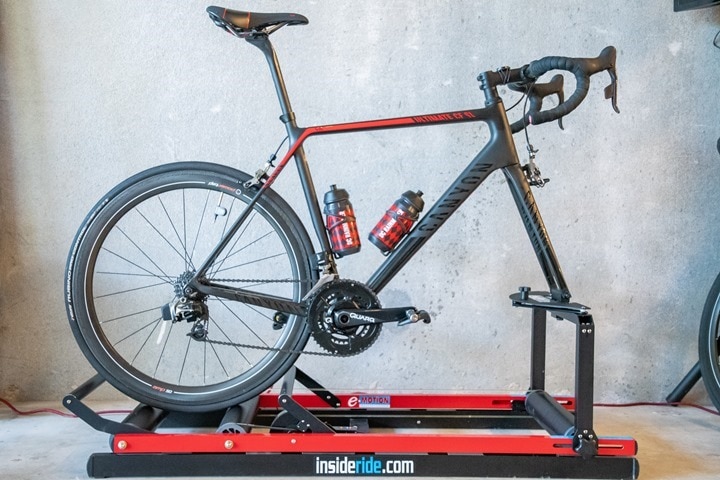

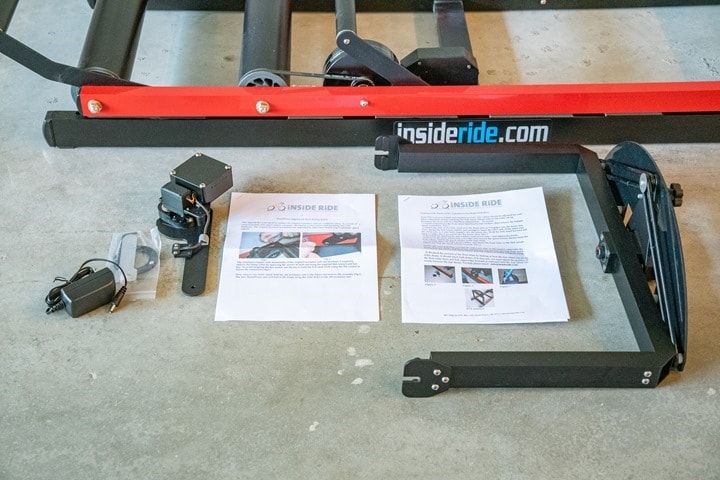
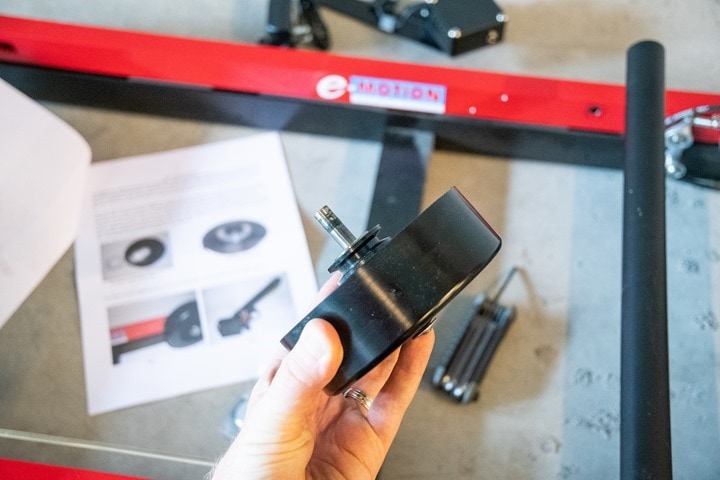
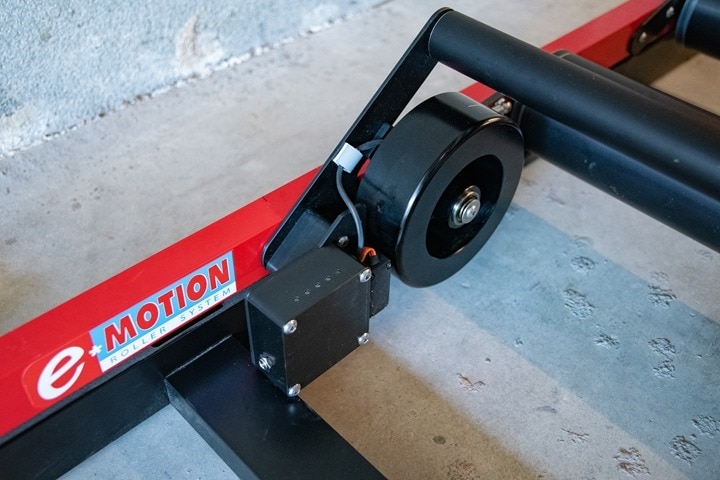
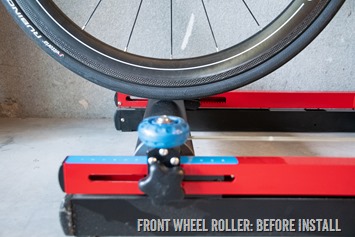
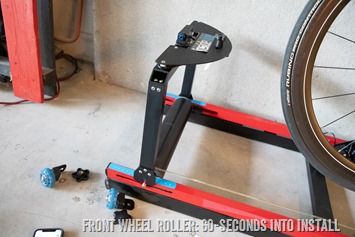
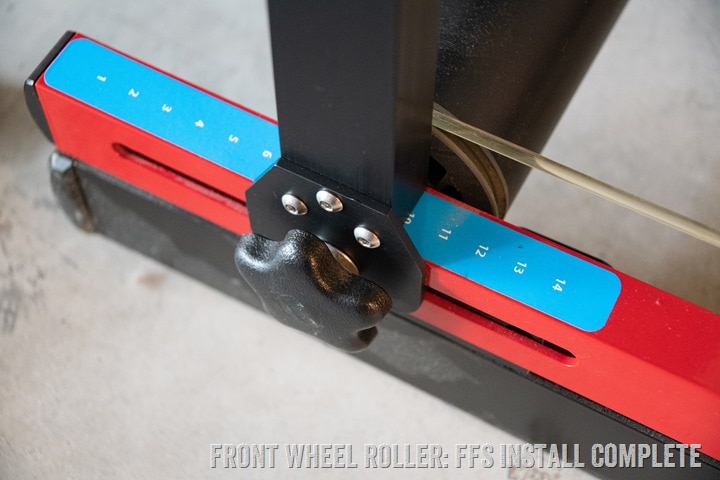


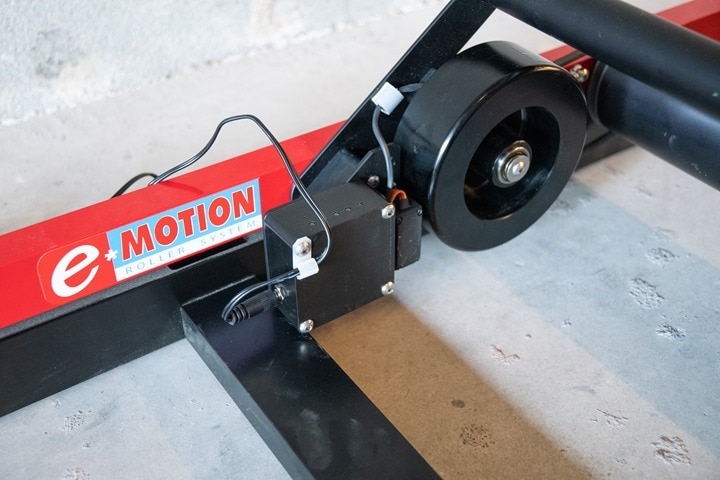
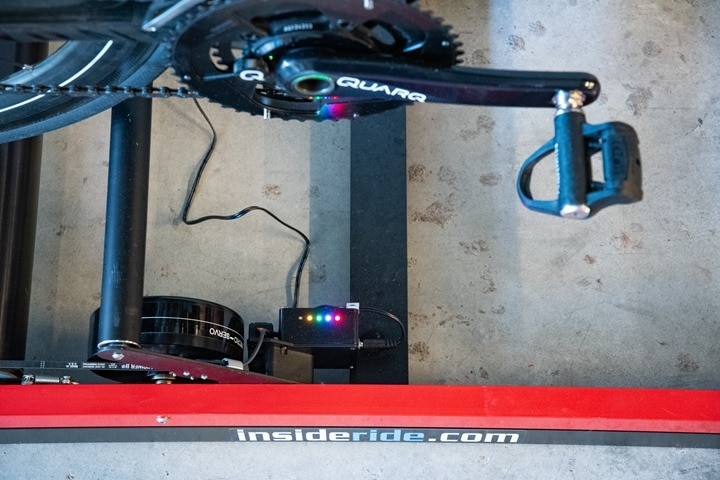
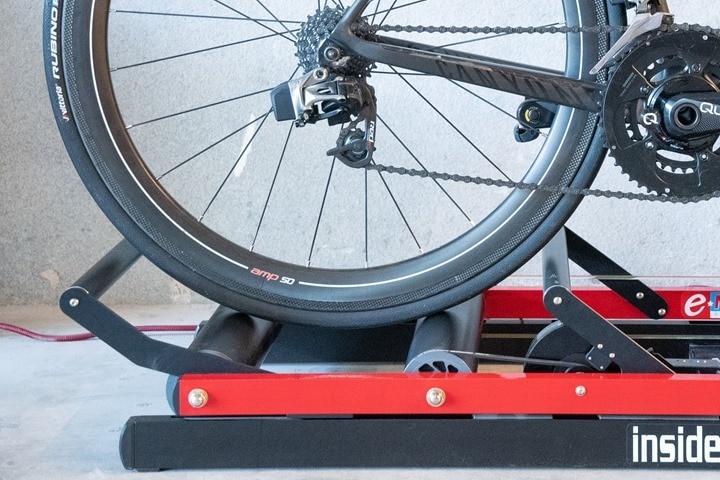
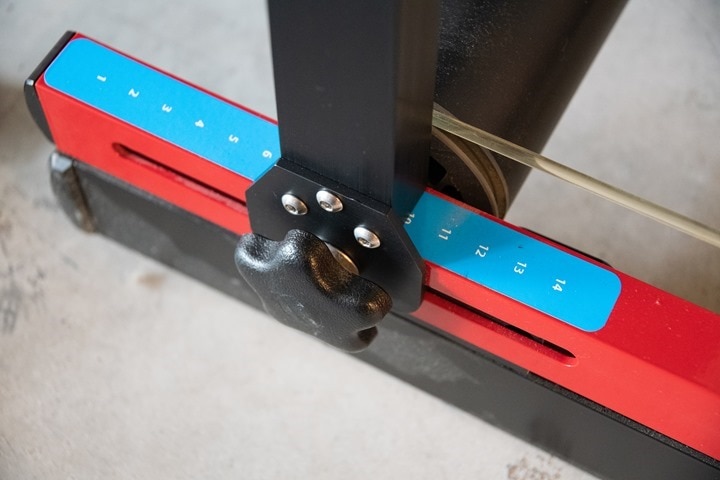
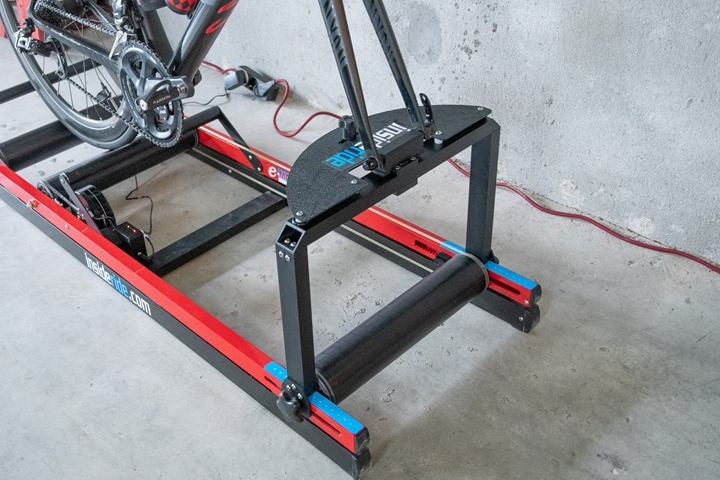
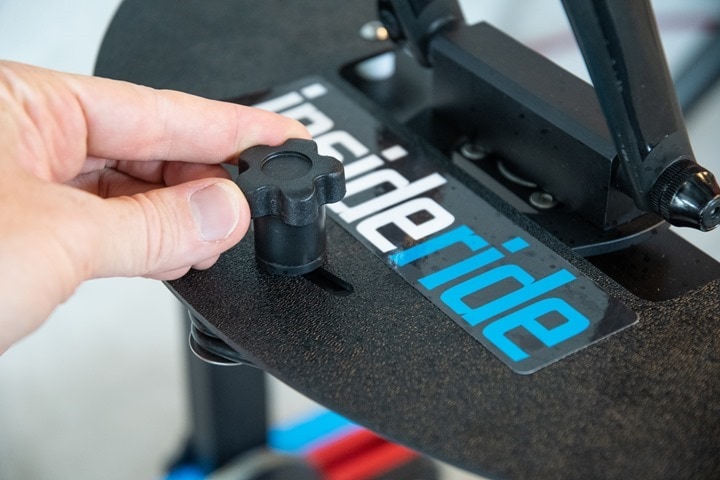
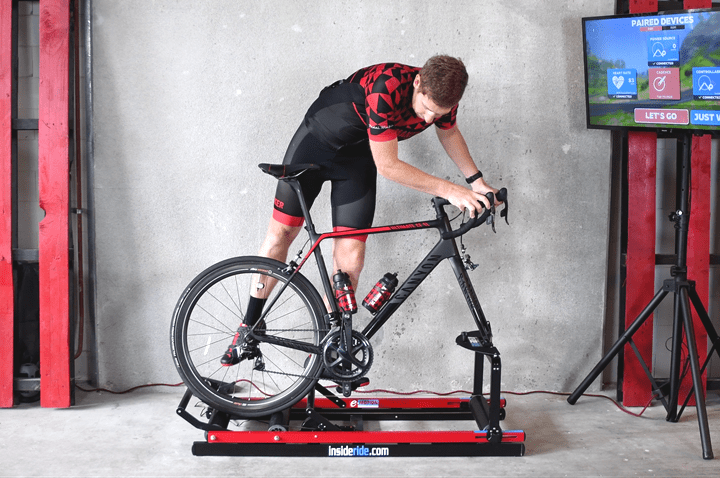
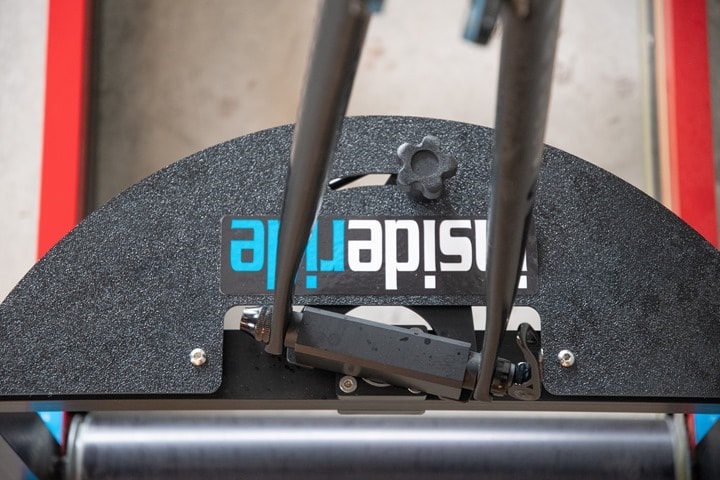

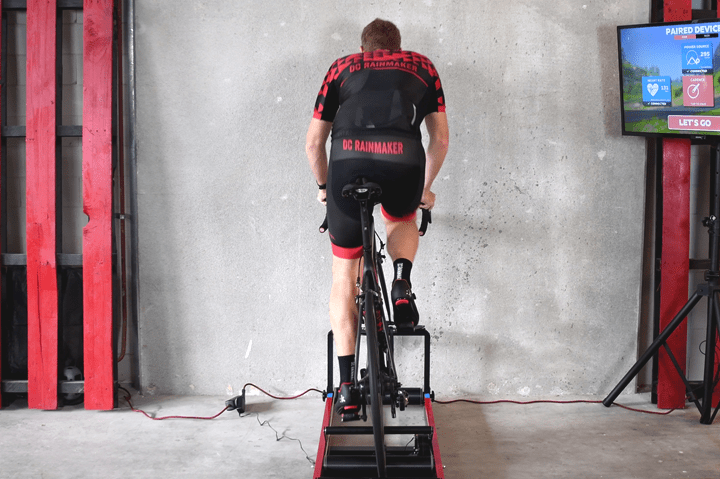

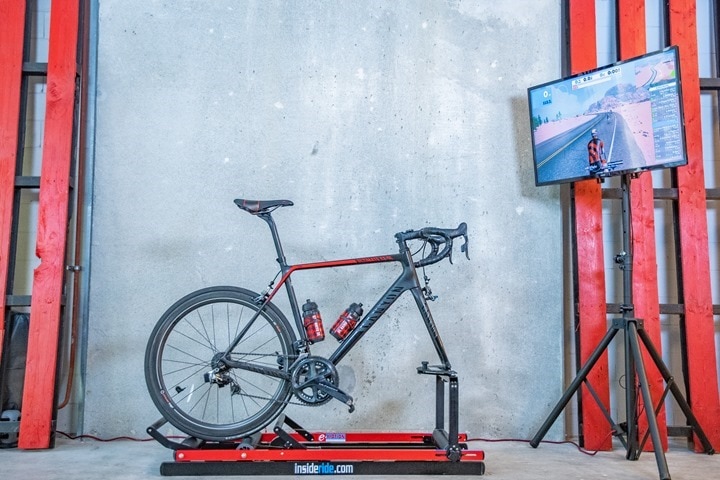
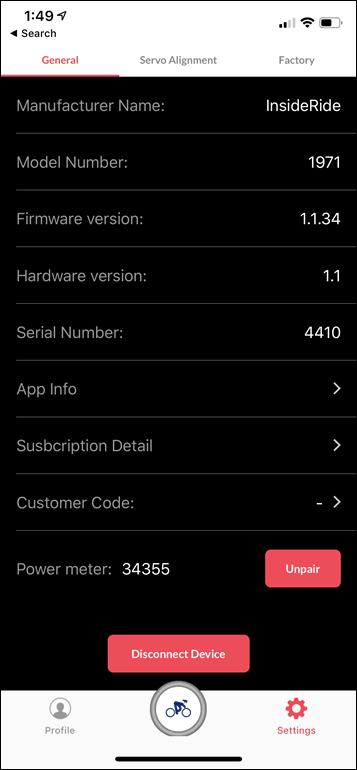
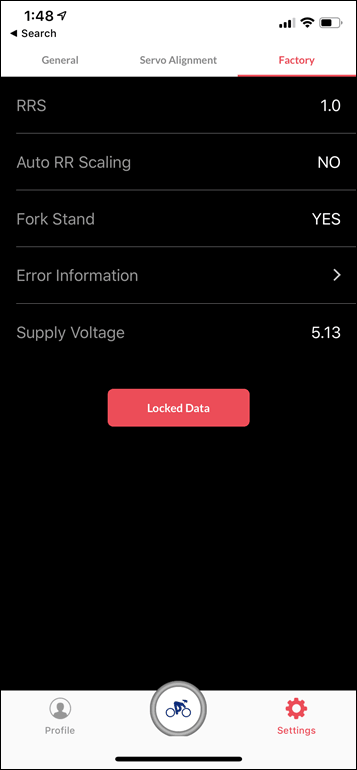
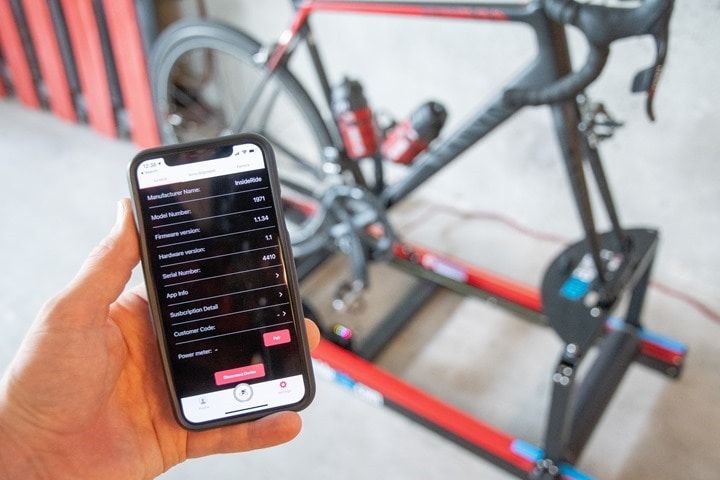
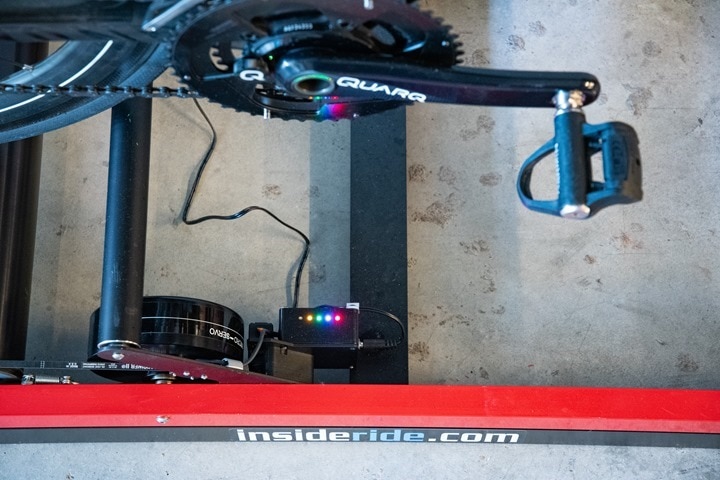
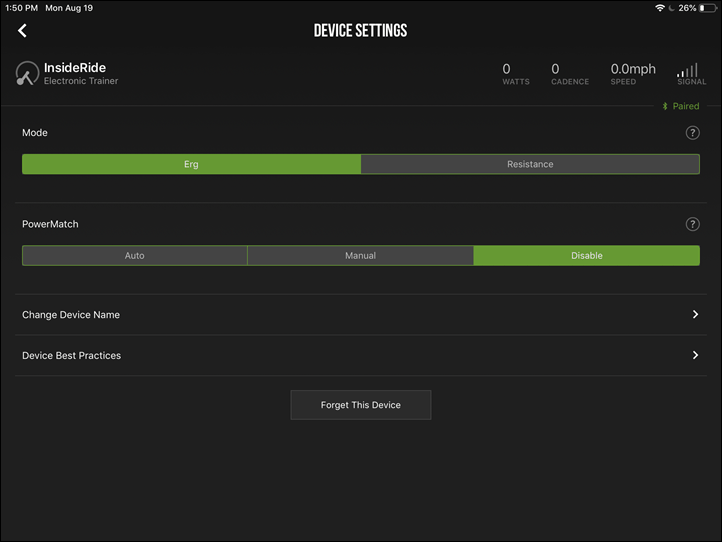
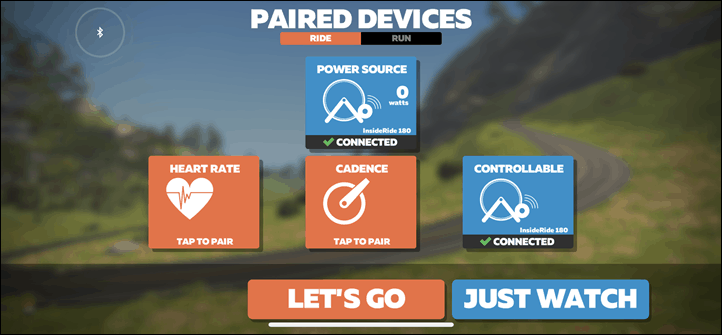
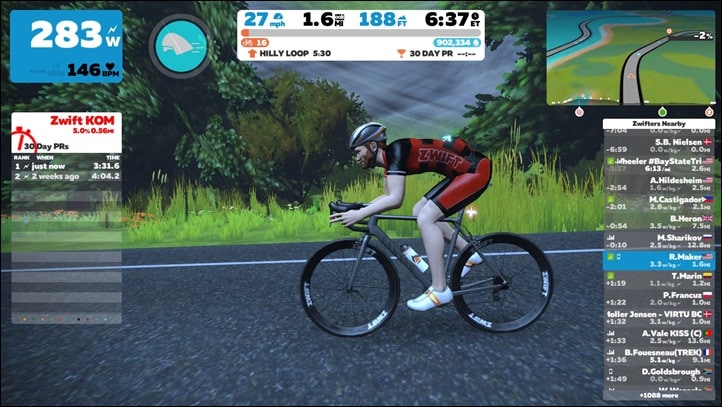
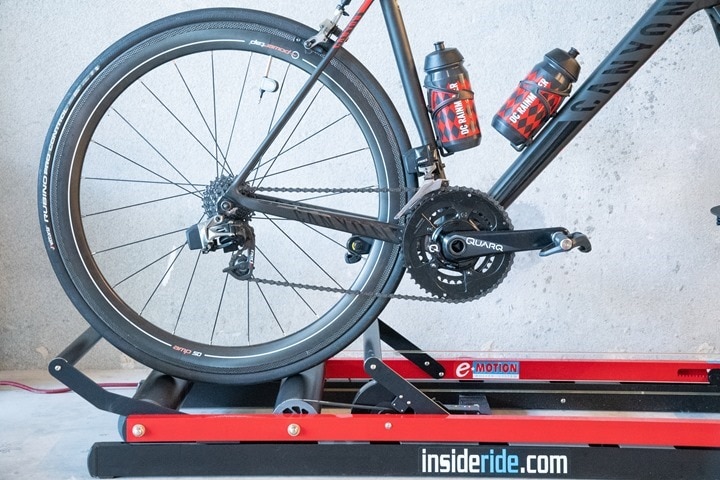









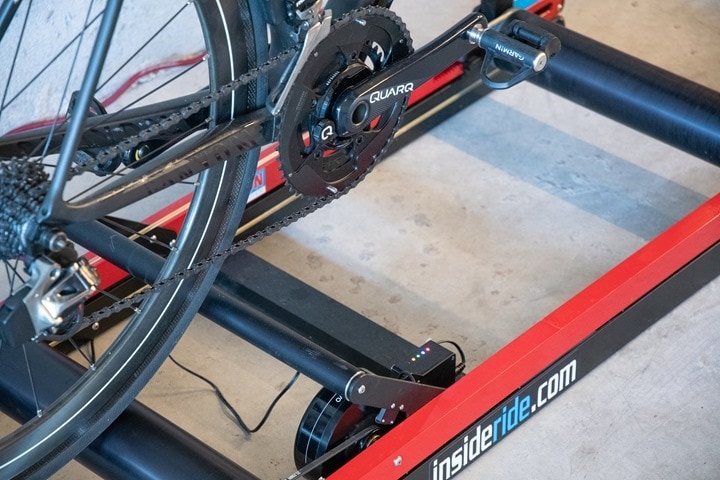


















FFS… catchy. As you say this piece sold separately may be a good thing on on other trainers.
It doesn’t get you the fork movement, but if people are looking for a little movement on the trainer in order to make long rides a little more comfortable than buy a feedback sports omnium. You could get the progressive resistance model and a power meter and still spend less than what this system costs (I got my omnium for about $300 with my 20% off coupon from DCR and Clevertraining). As an added bonus you have a trainer that you can take anywhere.
The lack of a flywheel and wheel inertia does take some getting used to, but I use the Omnium as my daily trainer for everything from long endurance rides to VO2 max sessions. I also definitely notice that with the back wheel free I have less saddle discomfort than I do when I am locked into my kinetic roadmachine.
This is a cool idea, but that price…yikes…
Carter Terry, I think you might be missing the point of building motion into the system. The benefits are substantial, so it doesn’t make much sense to suggest that a near-rigid system like the Omnium will provide the same thing for a fraction of the cost. The Omnium is a nifty little device, but it’s still quite basic.
Hello,
I am curious about rollers, having never tried them. What is your take on tire wear compared to a traditional wheel-ON trainer? Would it affect the front tire (assuming no fork) too?
I’ve been in the trainer camp for a few years, but how do I find out if I am really a roller guy? I have never seen them set up at bike shops to try out (and I’ve seen plenty of shops with trainers set up). Maybe more of a liability with customers falling off.
I’ve been riding rollers (currently Kreitler 3 inch) for many, many years. It’s all there was when I first started riding indoors. Tire wear is a non-factor. They basically don’t wear at all on rollers.
(Even outdoors, my front tire essentially never wears. A long time ago I read a suggestion that tires be rotated from front to rear when the rear tire is replaced, so that your best tire is on the wheel that steers, and that’s what I’ve been doing.)
Rollers are tricky. You have to learn how to ride them (best to start learning in a doorway so you can’t fall very far), and you have to pay attention at all times. You can’t let your mind wander like you can on a trainer. I’ve been using a STAC trainer for a couple of years now, and I prefer it day to day over rollers. I still use the rollers in the spring/summer/fall because it’s much easier to set them up and use them for a day here and there than a trainer. Rollers also force you to adopt a smoother style (or else). Some people with skills can take their hands off the bars or stand when riding rollers. I’d never dare try either.
I’m a rollers person exiled on a Neo due to noise concerns. Tire wear was never an issue for me and I did enough hours on rollers to even encounter a flat once (some road debris lodged in the rubber happened to work itself through during a rollers session, what are the chances… well, better than having that same flat outside I guess). On rollers, even those with a brake unit, you never simulate an incline. What you do for a high watts interval is keep resistance moderate, but spin up to very high speed. This way, the forces transmitted by the rear tire stay much lower than on a trainer.
I was a “rollers guy” about 20-30 years ago. What the others said is true. To me, the greatest benefit of rollers is that they smooth out your pedaling better than riding a fixie. If you’re pedaling squares, you’re eating the wall in front of you very quickly. Cyclists today don’t care about pedaling smoothly but they really appreciate when they’re in a paceline behind somebody who does. Today’s cycling world need more rollers! (true rollers that don’t float and without fork stands)
I no longer ride rollers due to injury history (not roller related) and frailty of age. That said, my pedaling could really benefit from 15 minutes a week on rollers
Aar,
I just thought I would give my take on your comments.
The thing people often don’t realize about floating rollers is they have the same pedal smoothing effect as old school rollers.The smoother you pedal, the less they move, so the feedback is there and it’s quite sensitive. It’s as good or better at conditioning your pedal stroke.
Your injuries make rollers less attractive, but if you ride our rollers with the floating fork device, your pedal stroke will benefit greatly without the possibility of crashing into the wall.
I always felt I got much better “all over” work out on rollers than a fixed trainer. Talking from experience I’ve never had a wiley-coyote style accident where I’ve come off them and rolled forward into the wall or tv , there’s just no forward momentum. ?
Similar to Paul, I’ve ridden Kreitler rollers for a quite a while and found that tire wear hasn’t been an issue.
I think the key to building confidence on rollers is to try and keep your shoulders relaxed with a light grip on the bars. Also, by setting them up in a doorway with your arms/shoulder in line with the door frame you can use them as “bumpers” to re-center yourself if you get too close to the edge. I used this setup to get comfortable enough to ride out of the saddle, although no sprints or no hands yet ;)
On the notion of riding into a wall if you fall off, that’s a myth. I’ve fallen off a couple of times and all that happens (other than a bruised ego) is that you might leave a tire mark on the floor. If you don’t believe me, put it in the big ring, lift the back wheel, spin it up to a decent speed and then drop the rear wheel onto the ground (preferably outside to protect your floor). Now imagine adding your body weight to the rear wheel as it makes contact with the ground.
I added the Killer Headwind fan which can add well over an additional 1000 watts of resistance while also keeping you cool (link to kreitler.com) and that alleviated the issue of not having the resistance that a trainer can offer. The fan can be a little loud though.
Finally, a couple things to consider:
* Kreitler offers a lifetime warranty and uses ABEC 5 bearings.
* Kreitler is also made in the USA.
* Kreitler offers a fork stand, albeit fixed.
* The Kreitler frame can fold for storage/transport to a race, etc.
* The e-motion system is interesting, but the primary benefit of rollers is to develop smoothness and this seems to compensate for a lack thereof.
Clearly, I’m a fan of Kreitler and I think it’s a better value to buy a set of their rollers with the fan to add resistance since they’ll never be obsolete and they’ll last a lifetime (replacement belts are available).
What happens if/when InsideRide stops supporting the electronics or the technology advances? I think it’s smarter to buy a separate power meter for the bike (if you don’t already have one) which will also allow you to use the rollers with Zwift, etc. At least if something happens to that power meter, it doesn’t affect the feature set of the rollers. Yes, this is a more expensive route than just buying an Inside Ride by itself, but it’s more future proof and you’ll have a power meter that you can use outside too.
Cheers
Hi Ray,
Small comment on videos in the reviews etc (it could just be me with a setting, if so sorry)
I can’t give the embedded videos a thumbs up like. I have to open the video in youtube to be able to do that.
I appreciate it’s important for your channel to get likes and just wondered how to easily do this, or do I have to open up in youtube each time? Surely this isn’t intentional by youtube to switch you on to their platform to get their ad stream displayed… or is it.
Again sorry if I have a setting and it’s just me.
Unfortunately it’s a YouTube thing. :( There isn’t a like button on embedded videos. :(
I suspect it’s because they want you sucked into their platform so they can quickly get you hooked on cat videos. Or at least, that’s sorta how it works for me.
I appreciate the attempt though!
“That said, I think it’s in any companies best interest to occasionally higher a graphic design artist (even if on Fiverr) to clean-up stuff like this and present oneself as an option equal to the much larger players.”
I think you picked the worst possible sentence in the whole article to have a mistake… the one where you criticized their directions. ;-)
I do appreciate the write-up, and I’ve always been tempted to try rollers, but… I think I agree with you. For that kind of money, I need power accuracy.
Hi DCR,
I have just read the review and watched the video, the what really stood out was that whilst the fork mount does allow some movement, the bike appears to move in the opposite direction to what it would if you were riding on the road. In the video, when the left pedal is down, the bike moves to the left where as if you were riding on the road, the bike would move to the right to avoid tipping over and falling off.
I just wanted to ask if it actually felt like this whilst you were riding?
With this being the case, I would assume it is not coming anywhere close to biomechanically replicating real life outdoor riding – and this would be the same scenario with rocker plates on other fixed indoor trainers as well.
Agree…it appears that the stress on ones bike isn’t natural and appears that undo stress is being put on the head-tube area and maybe even forks? When it’s locked up front, it seems better, but then what’s the point of this vs. wheel-off smart trainer in that config?
Hi this is Larry from Inside Ride.
I noticed that too, but since the tilting is tied to handlebar pressure, he’s got direct control of the amount and direction of the rocking motion. He just needs to apply a bit more upward force on the bars to oppose the downward force at the pedal.
You can go from a negative tilt (wrong way) to zero tilt, to full-sprint positive tilt by just balancing the arm force with the pedal force. That’s pretty much automatic when you ride outside, but you have to re-learn the habit on a trainer. Give him a few more minutes on it and he’ll be golden!
Han Solo, Larry from Inside Ride here.
It’s actually just the reverse of what you said. When the system is unlocked, there’s no additional frame or fork stress because you’re balanced and floating. When it’s locked, and you’re hammering away, the forces that want to tilt the bike will be taken by the fork, so it’s designed to be used primarily unlocked. The lock was included to help new riders, but it’s not really needed. The upcoming Kickr/Neo versions will not have a lock.
“The upcoming Kickr/Neo versions will not have a lock.”
the what? NEO version? details plz
This contraption to put a neo on (front and back) and i am a buyer..
Very interested in your upcoming KICKR floating fork device. Hope you will support the KICKR Snap wheel-on trainer, and not just the wheel-off versions.
I can confirm these are coming. The Kickr version in several weeks, and the Neo to follow later this Fall. They will be full 3D motion systems (fore/aft/tilt) and will all be labeled as the “E- Flex” model line.
Larry, Inside Ride
Wrong order.. Neo rules kickr.. seriously though.
Looking forward to the kickr version
I’ve had these rollers for 5 years now and love using them. They have held up exceptionally well so far. I haven’t tried their new smart resistance unit yet but have been using for a few yrs. the Elite add on one they used to sell. Personally Zwift sessions on these is super engaging. Yes the power accuracy of the unit itself is not on par with smart trainers and giving the nature of the setup I can imagine it is a challenging problem to solve. That being said I’m going to suggest people interested in this product either fall into the camp of caring about power measurements or don’t. If you do care about power measurements then it is highly likely you already own a power meter as well and are using it. Regarding the fork stand, I haven’t tried it and don’t personally see a need for it. I’ve done many Zwift sessions with my computer on a stand in front of me while also watching TV. Really staying upright on these is almost an after thought (like riding outside). I’ve done 3+ hr. rides on them, as well as full on interval sprints without any issues. Honestly I find it hard to imagine anyone who actually rides a bike outside needing more than one session to get comfortable riding on them. For me personally, when I’m on them I feel like I’m cruising down a perfect stretch of Rd.. I like feeling my bike move around and being accountable for keeping things upright. You get the added benefit of strengthening your stabilizer muscles and core as well. For me, having my bike locked onto a trainer just doesn’t simulate riding outside; an important part of the road feel equation. Every product has their weaknesses and strengths and I’m going to suggest that Ray has overlooked a number of strength these rollers have which makes them a valued training tool/purchase.
Ed, I couldn’t agree with you more. Riding the Inside Ride e-motion rollers is transformative for indoors training and managing massive boredom. It is exactly like riding outside. Reading complaints like not paying attention may result in a crash is exactly what happens while riding outside. In contrast, how anyone can slog along pounding on a trainer, which is essentially a glorified stationary bike, is utterly beyond me. I get it, it’s better than nothing, but it’s not remotely better than the similar fun of actually balancing and riding offered by rollers.
Also, I loved your description of cruising down the perfect stretch of road. That’s it, precisely. Love it.
Lastly, I’m not worried about the powermeter inside the rollers because I have ALWAYS used my own powermeter on my bike for measurements. Sounds like DCR’s recommendation here is to link my powermeter to the app, link my speedo to the app (mileage addict), link the rollers to the app, and away we go. Plus, I get cadence from my powermeter.
My only lament is that my e-motion rollers are TOO OLD to update to the new version. So I have to consider the expense of buying a whole new one. Hmmm…..
I have a set of the insideride e-motion rollers…
They are great to ride on as rollers, but with that fore/aft play that makes them really stable.
But my wife could never really get used to it, so we added a fork stand (rigid only at the time). Suddenly, I could ride rollers, but she didn’t have to. It was a little annoying to put the stand and bike on vs just setting the bike on and rolling, but no harder than sharing any other trainer.
There came a time where we both wanted to ride at the same time… so we added a Neo. For noise and ERG/sim mode it’s great obviously, but I still prefer riding on the rollers.
You can’t coast for long, it is louder, and you do have to pay attention just a little… but once you have the hang of it it teaches some great lessons in balance.
If I had to start again and could only have one trainer…
The e-motion rollers are great on their own, and have the option of a fixed(or floating) fork (for you or addition riders). The resistance is fine for all but the hardest sprints. The wheel on\direct drive trainers could be better for the resistance control, but don’t have the option of becoming rollers.
These are definitely at the high-end of indoor cycling devices, and brilliant for those of us who live in cold climates. Trying to do Zwift style riding on normal rollers is tricky when corners are involved so these stands make focused training available to all. However I still feel that an Omnium style device (magnetically) controlled by one’s own power meter, for $500 or thereabouts, would be the perfect assisted-erg-rollers combination.
is this compatible with disk break bikes?
Their FFS page claims: “Compatible with quick release and most 12mm through-axle forks.”
So that would seem to include most road bikes with the 12mm x 100mm axle size. Some roadies use 15mm axles, and it would seem those will not work.
Thanks to the more natural movement, and because I do multi-hour trainer rides, this may be my next trainer! I’ve never been a roller person but I think this would get me to cross the line. Since I already have pedal power meter I don’t ever use the trainer’s power meter anyway, so power matching is just fine by me.
Concerns:
1. Front fork stress, both locked and unlocked.
2. Disc brake compatibility.
Design improvement:
1. Do something with the power cord rather than have if dangling around. That’s a hazard waiting to happen.
Howie I can help answer these.
No fork or frame stress when unlocked.
The force on the fork increases if you lock it and ride hard out of the saddle, but because of the direction of force, the fork is well equipped to handle it. Even with it locked, we’d rate the fork stand as being less stressful than clamping the rear triangle of the bike into a fixed trainer.
The power cord…because the entire system is moving back and forth, the cord is a tough thing to nail down tight. You’d almost have to build a special tunnel for it, but then you lose the option of routing it in another direction. It might make more sense to add a battery and get rid of the cord (except for charging).
@InsideRide, thanks for the input.
Are you one person or several? Would you mind sharing name(s) so we can address you properly? ?
As a long time form & function designer, the power cord needs to be contained in some fashion. People are stupid, and mistakes happen; limiting the potential for issues is important.
Any input on disk thru-axels? “Most” 12mm only? Clarifications would be appreciated.
Tnx
Howie, this is Larry from Inside Ride. It’s just me on this forum.
Regarding the thru axles, we are compatible with 12mm only. We use the word “most” because there are some systems (like the RAT and maybe some other hybrids we are not aware of) that may require some kind of creative steps to get them fastened properly. Thru axle systems are always evolving. We are not aware of any central information registry where all the various systems are detailed, so we take them on as we encounter them. We appreciate any input you might have.
The power cord question…With a moving frame it’s always going to be an issue, so we are considering a battery pack as the ideal solution. No cord, no problems.
Thanks for reviewing these – I’ve been hoping you would for a while, just for comparison sake with other trainers. I’ve had a set of InsideRide rollers for about 5-6 years, just added the smart resistance unit and FFS last November. I also use them on Zwift and Trainerroad, with my Quarq paired to the rollers….I’m pretty happy with them overall, but I do sometimes see a lag in erg mode with the rollers getting up to target (I’ve had it take up to 30 sec to go from 100w to 240w). I used to have a Gen 1 KICKR as well, but sold it when I bought the smart resistance….sort of wondering now if I should have held on to it, as the pair would’ve been sort of the best of both worlds.
Forward and backward movement is what prevents that clunky dead spot at the bottom of the pedal stroke you get on trainers when standing. A trainer that had forward/backward movement, or equivalent elasticity in the drive would do this too. Whatever happened to that big Saris trainer platform?
Fore-aft movement does improve feel by allowing our center of mass movement to happen with less restriction (compared to a fixed trainer or rollers). I’ve used F-A motion on my DIY motion rollers (inspired by these) and my adaptation for rocker plates. In both instances, it improves the standing feel greatly, especially at more aggressive power output levels.
The CycleOps “Thing” may well be coming to Eurobike in a few weeks. Pure speculation, but a more refined version (may we say production ready?) was seen at the women’s race parallel to the TdF. I can’t find the link now, but Ray or Shane miller caught pics of it at the team bus.
Long time roller guy here, and I’ve never owned a stationary trainer. I bought I used InsideRide set about 6 years ago, and have to say the floating frame concept they have pioneered is truly a game changer. The back and forth motion allows you to stand out of the saddle, sprint and (importantly for me) get up and stretch your back. I wouldn’t dream of going back to fixed rollers again. If the new fork mount and smart controller introduces more people to rollers, even better.
What’s up with the Elite Nero? Thought you got a test unit a while ago? Can you say anything about it?
Just need to make the floating fork rise and fall like the Kickr Climb and we’re in business!
I’ve used standard InsideRide rollers for years. It’s a great product. That and Netflix and a SRM is all I really need for winter training or in season focused intervals. You can move around on your bike, balance and sprint – almost like road riding. I have used Wahoo and other Smart trainers and always have gone back to standard my InsideRide.
Simplicity and a clever design often beats bells and whistles.
Just want to add another vote for inside ride rollers. I have a set as well as a kickr, and I almost always choose the rollers to ride since it is more enjoyable. Unfortunately, you definitely need a powermeter since the power on the rollers is no where close to correct no matter how many times you calibrate them. I honestly don’t understand why you would want the fork mount though? Even with a full sprint you can’t fall off unless you’re really trying, and the whole reason I keep choosing these to ride is because they are more engaging than a trainer. To me the fork mount would take that away, but to each their own I guess.
Looks like they publically announced the kickr version on their web page. Any look at them planned? link to insideride.com
$499 seems like a good price link to smartbiketrainers.com
That’s pretty cool. I’d like to see Ray do a video with it!
According to FedEx, it arrives in the morning.
So plenty of time for a video, right? :-p
I’m really curious to see your take on the kickr e-flex version of this, and hopefully a motion video. Wondering how the motion really compares to how the bike moves outside. I’m skeptical if you have to turn the handlebars to cause the bike to lean, that doesn’t seem to match up with how I’d move outside, but maybe I’m wrong.
Does the trainer work with disk wheel forks?
Also what brand of tripod is that? How big is that TV?
When I was a little younger riding track bikes full speed in the city, I rode on a trainer and rollers at our college house. The rollers are a skill unique to them specifically and in my opinion do not replicate riding outdoors any more than a trainer. The ability to get squirrely and crash on the rollers only takes a split second mistake. The trainer teaches endurance plodding through a very long boring stretch without making it complicated. If I was gonna try to get in some good aerobic hours I would choose the trainer. Dont get me wrong, Im a badass on rollers. No hands, standup track sprinting, mount and dismount while staying clipped in no big deal….but I still would choose a trainer. But hey, what do I know.
I have a set of the standard insideride e-motion rollers and really like them. I also have some Kreitler 4.5 and Nashbar reduced radius rollers. The insideride rollers are on a completely different level. The build quality is superb and also more road like feeling than other rollers.
I can’t ever see going back to a stationary trainer again. I have my Kurt Kinetic Rock and Roll 2.0 for sale.
I don’t see the need for the fork stand. Kind of takes the point out of riding rollers.
What a difference! The new Smartpower unit is a dramatic improvement over the old Qubo unit and the even older power control unit Inside Ride first produced. I just retro-fit the new unit to my rollers having used the Qubo version for a couple years.
The accuracy and responsiveness is great. The app works well. I’m very pleased.
How did you get this trainer shipped to Amsterdam? I’ve contacted insideride.com and I was told that they ship to the US and Canada only.
They had sent out a review unit, so kinda a one-off.
I have contacted InsideRide again: They’re able to send the parcel to a so-called “forwarding company” in the US who then send the parcel to Europe. They have worked with the following forwardering companies in the past: fishisfast.com and shipito.com.
The parcel size is 60″x 22″ x8″ and weighs 42 lbs. I’ve just ordered, so let’s see how it goes…
Hello
There is no overseas distribution and shipping
individual units by parcel service is quite
expensive. The best option is to use a parcel
forwarding service to get the rollers shipped at
a reasonable rate. You would contact them through
their website to arrange service. Typically we
would ship to their facility in the US and they
would send it on to your international
destination. There may be size restrictions to some destinations.
Here are three services that customers have used
previously. The package size is 60″x 22″ x 8″ and weighs 42 lbs.
link to shipito.com
link to fishisfast.com
link to shopandship.com
Best regards
IR
Reference the power inaccuracies without a power meter and lack of spin down feature: If you use the InsideRide app, it allows you to manually adjust the rolling resistance (RRS) and it significantly increases the accuracy. My average power on indoor rides is within 5 watts of my outdoor rides.
In summary, there are three (not two) ways to calibrate these rollers.
1. Connect your powermeter directly to the rollers
2. Use your powermeter to calibrate the RRS
3. Manually adjust the RRS
Thanks for this review. I recently purchased these rollers with floating fork and sold my Tacx Neo 2. I have been training with TrainerRoad in Erg mode without much issue.
However I just switched to a different coaching system that is done through Training Peaks and I have to do my 20 minute ramp test in non-Erg mode. I’m planning to run Training Peaks via TrainerRoad but not sure what setting changes to make in TR to get the most accurate non-Erg experience. Any advice???
Happy New Year all!! This is my first post to DC Rainmaker.
I would like to say a huge “THANK YOU” to Ray and his incredible database of fitness product reviews. He is a huge influencer in the field, and I read, and use, his reviews all the time. Unparalled for comprehensiveness and being unbiased.
Living in Western NY state, for about 6 months of the year I ride mostly indoors, and only occasionally run. Riding outdoors, when I can, is always preferable. I have been a passionate rider for over two decades, and have used all manner of trainers. Originally a Blackburn simple press-on trainer, then many years on the Computrainer (which I loved- although am not surprised to see them go under since they never kept up with the times), to InsideRide E-Motion rollers (model F, so more than a decade ago) with an on-bike power meter, to a Kickr just over two years ago.
It’s all personal, but I have used many different indoor riding platforms, and still have them all. The only two that are still immediately available for use are the Kickr and the IR rollers. I use them both, but find I choose my rollers about 80-90% of the time. The realism of the ride, to me, is far superior to the Kickr. Definitely need to concentrate more with the rollers, but I have never fallen off or ridden off the rollers. I find myself just using my powermeter and Garmin computer to control the ride, using the magnetic resistance unit on the rollers and gear changes to change resistance. This keeps me more engaged and I find it easier to pass the hours indoors using this combination. I do not use the FFS at all.
I am sure others have different viewpoints. Just as Ray said, its like religion or politics- a very personal view.
I love my IR rollers, they are bombproof, as safe as rollers can be with their bumper system, and to me the most realistic indoor riding system. And NO, I have no relationship to InsideRide, and am not compensated for this post ;)
I have the Inside Ride Rollers with the SmartPower module. I use Garmin Vector pedals and linked to the module with “power match”. When I do a ride on Zwift (NOT ERG mode) I notice the displayed power lags the actual power (as seen on a Garmin head unit paired with my vector pedals). This happens when I use the SmartPower module as the “power source” when setting up Zwift. Any ideas out there on how to minimize/eliminate that lag?
Scott,
Connect your power meter directly to Zwift. Don’t do it through the rollers. There really is no reason to have it go through your rollers.
“Power” = Garmin Power Meter
“Control” = InsideRide
Thanks. For some reason, I get more power drop outs when I use the Vector direct to Zwift. It seems like I have a trade off between power match (with lag, but more reliable connectivity) vs direct connection with less reliability. Sigh ….
I believe when connecting a power meter directly to the rollers they do their own 3 second power average calculation which can’t be turned off. So in Zwift try going into settings and turning off the 3 second averaging option otherwise you are getting two average calculations happening. See how that works. If still off then on your Garmin try turning on 3 second avg. Personally I do as Ray said and connect my power meter directly to Zwift. No power drop outs. I recommend a USB extension cable if using ant+ and a computer. Also I find with Ant+ vs Bluetooth the roller’s resistance adjust to elevation changes slightly slower with Ant+ which I personally like more while riding around in Zwift.
If connecting via ANT+ make sure the sensor is within 3 feet of the receiver. Get an extension if that is how you must connect, otherwise I would do it via BTLE which has much better range.
Hi RGR,
Your advice was the excat answer to what I was chewing on when setting up my recently purchased Insider Ride in Zwift – many thanks!! Quick question: Do you still have your bike’s power meter paired with the rollers (=blue LED on) in this kind of setup?
Clemens,
No, I pair my power meter directly to Zwift. So when you are at the Zwift sensor screen this is what it needs to look like:
Power = Your power meter
Control = InsideRide
Candence = Your power meter (if it also has cadence, otherwise pair your seperate cadence sensor)
Heart Rate = Your HR monitor
So nothing is paired to the rollers and the only thing you are pairing your rollers with is the “Control” on zwift so it can control the resistance on your rollers.
How is the latency with that setup ? Worth spending 365$ for a better feeling in a racing context ?
I’ve got a set of elite Arion smart rollers, but I found when the resistance kicks in too suddenly, my technique let’s me down and I have the odd ‘moment’. Something like the fork mount on its own would be brilliant. I’ve cobbled together something using and old chair and a roof rack fork mount, but it doesn’t quite work 😔
Are there any plans for a standalone fork mount, or is anyone aware of a properly engineered one available?
Hey!!
great review, definitely a product that I look at a lot. Since you try the rollers they have changed the smart module; wanted to know if, to your knowledge, this has solved the power accuracy issue you have highlighted above (~10%).
THX!!
Olivier
Power accuracy is still not great with the new resistance module on its own and I don’t expect that will ever change. That being said, if you have a power meter you can either link it to the rollers and it will then provide accurate power readings, or you can link the power meter directly to the application you are using. I’ve been using mine for years and they work just as well as the day I purchased them and training on them feels amazing. For me reliability and enjoyment of using the product takes priority over accurate power readings as I was able to correct for the latter via a dedicated power meter.
Dear Ray,
tried the roller out since a few days cause I want something not that static for longer indoor rides. Using an app like Rouvy is working great, but it gives me serious waves in the resistance especially uphill. I can see those small lever moving all the time and great the servo, it’s like when the gradient comes from 5 to 4.5% the unit is overreacting. As you wrote, at higher speed is better but I can still see and feel it, and we are not talking that I try to simulate 10% in lightest great, can feel it from about the % and on the 8th of 12 gears (but small chainring in front). Tried with pomerweter paired to the app (most times) and to the roller, no difference. Any ideas?! Thanks
How does this Ultimate setup compare with the E-Flex (Kickr)? Would there be any reason to have both?
I recently came across a screaming good deal on the Ultimate roller setup (with floating fork). Aside from the app not being updated to work on latest android, it seems great so far.
I also have a 2018 Kickr with Climb and a cheap wooden rocker (left right only). I’m debating if I should just sell the Kickr all-together, or if it would be worth selling the climb unit and getting the E-Flex in it’s place….or just keeping the current kickr / wood rocker setup for intense workouts.
I’m guessing it’d be more quiet than the rollers, but would it be that much better in terms of comfort, ERG, sprints, and quick reaction to hills in Zwift?
Are the rollers with floating fork still more comfortable than a Kickr on the E-flex plus, and (almost) as good for all scenarios?
I should note – I have pedal based power meters to sync with the smart rollers, so I’m not relying on the roller power output.